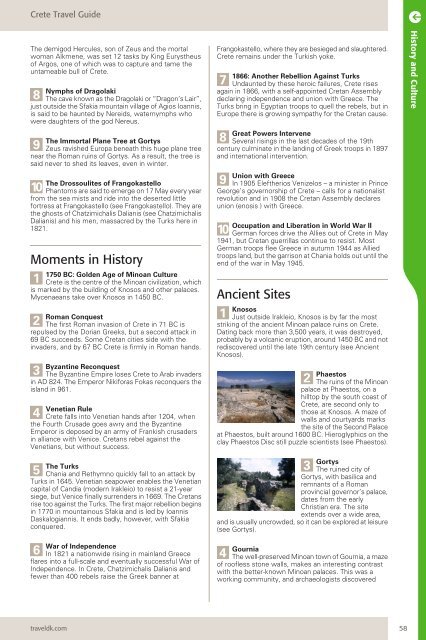CRETE TRAVEL GUIDE
CRETE TRAVEL GUIDE
CRETE TRAVEL GUIDE
Create successful ePaper yourself
Turn your PDF publications into a flip-book with our unique Google optimized e-Paper software.
Crete Travel Guide<br />
The demigod Hercules, son of Zeus and the mortal<br />
woman Alkmene, was set 12 tasks by King Eurystheus<br />
of Argos, one of which was to capture and tame the<br />
untameable bull of Crete.<br />
8<br />
Nymphs of Dragolaki<br />
The cave known as the Dragolaki or “Dragon’s Lair”,<br />
just outside the Sfakia mountain village of Agios Ioannis,<br />
is said to be haunted by Nereids, waternymphs who<br />
were daughters of the god Nereus.<br />
9<br />
The Immortal Plane Tree at Gortys<br />
Zeus ravished Europa beneath this huge plane tree<br />
near the Roman ruins of Gortys. As a result, the tree is<br />
said never to shed its leaves, even in winter.<br />
10<br />
The Drossoulites of Frangokastello<br />
Phantoms are said to emerge on 17 May every year<br />
from the sea mists and ride into the deserted little<br />
fortress at Frangokastello (see Frangokastello). They are<br />
the ghosts of Chatzimichalis Dalianis (see Chatzimichalis<br />
Dalianis) and his men, massacred by the Turks here in<br />
1821.<br />
Moments in History<br />
1<br />
1750 BC: Golden Age of Minoan Culture<br />
Crete is the centre of the Minoan civilization, which<br />
is marked by the building of Knosos and other palaces.<br />
Mycenaeans take over Knosos in 1450 BC.<br />
2<br />
Roman Conquest<br />
The first Roman invasion of Crete in 71 BC is<br />
repulsed by the Dorian Greeks, but a second attack in<br />
69 BC succeeds. Some Cretan cities side with the<br />
invaders, and by 67 BC Crete is firmly in Roman hands.<br />
3<br />
Byzantine Reconquest<br />
The Byzantine Empire loses Crete to Arab invaders<br />
in AD 824. The Emperor Nikiforas Fokas reconquers the<br />
island in 961.<br />
4<br />
Venetian Rule<br />
Crete falls into Venetian hands after 1204, when<br />
the Fourth Crusade goes awry and the Byzantine<br />
Emperor is deposed by an army of Frankish crusaders<br />
in alliance with Venice. Cretans rebel against the<br />
Venetians, but without success.<br />
5<br />
The Turks<br />
Chania and Rethymno quickly fall to an attack by<br />
Turks in 1645. Venetian seapower enables the Venetian<br />
capital of Candia (modern Irakleio) to resist a 21-year<br />
siege, but Venice finally surrenders in 1669. The Cretans<br />
rise too against the Turks. The first major rebellion begins<br />
in 1770 in mountainous Sfakia and is led by Ioannis<br />
Daskalogiannis. It ends badly, however, with Sfakia<br />
conquered.<br />
6<br />
War of Independence<br />
In 1821 a nationwide rising in mainland Greece<br />
flares into a full-scale and eventually successful War of<br />
Independence. In Crete, Chatzimichalis Dalianis and<br />
fewer than 400 rebels raise the Greek banner at<br />
traveldk.com<br />
Frangokastello, where they are besieged and slaughtered.<br />
Crete remains under the Turkish yoke.<br />
7<br />
1866: Another Rebellion Against Turks<br />
Undaunted by these heroic failures, Crete rises<br />
again in 1866, with a self-appointed Cretan Assembly<br />
declaring independence and union with Greece. The<br />
Turks bring in Egyptian troops to quell the rebels, but in<br />
Europe there is growing sympathy for the Cretan cause.<br />
8<br />
Great Powers Intervene<br />
Several risings in the last decades of the 19th<br />
century culminate in the landing of Greek troops in 1897<br />
and international intervention.<br />
9<br />
Union with Greece<br />
In 1905 Eleftherios Venizelos – a minister in Prince<br />
George’s governorship of Crete – calls for a nationalist<br />
revolution and in 1908 the Cretan Assembly declares<br />
union (enosis ) with Greece.<br />
10<br />
Occupation and Liberation in World War II<br />
German forces drive the Allies out of Crete in May<br />
1941, but Cretan guerrillas continue to resist. Most<br />
German troops flee Greece in autumn 1944 as Allied<br />
troops land, but the garrison at Chania holds out until the<br />
end of the war in May 1945.<br />
Ancient Sites<br />
1 Knosos<br />
Just outside Irakleio, Knosos is by far the most<br />
striking of the ancient Minoan palace ruins on Crete.<br />
Dating back more than 3,500 years, it was destroyed,<br />
probably by a volcanic eruption, around 1450 BC and not<br />
rediscovered until the late 19th century (see Ancient<br />
Knosos).<br />
2 Phaestos<br />
The ruins of the Minoan<br />
palace at Phaestos, on a<br />
hilltop by the south coast of<br />
Crete, are second only to<br />
those at Knosos. A maze of<br />
walls and courtyards marks<br />
the site of the Second Palace<br />
at Phaestos, built around 1600 BC. Hieroglyphics on the<br />
clay Phaestos Disc still puzzle scientists (see Phaestos).<br />
3 Gortys<br />
The ruined city of<br />
Gortys, with basilica and<br />
remnants of a Roman<br />
provincial governor’s palace,<br />
dates from the early<br />
Christian era. The site<br />
extends over a wide area,<br />
and is usually uncrowded, so it can be explored at leisure<br />
(see Gortys).<br />
4 Gournia<br />
The well-preserved Minoan town of Gournia, a maze<br />
of roofless stone walls, makes an interesting contrast<br />
with the better-known Minoan palaces. This was a<br />
working community, and archaeologists discovered<br />
58<br />
History and Culture
















